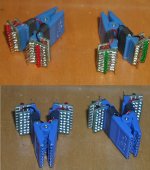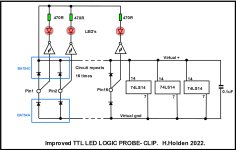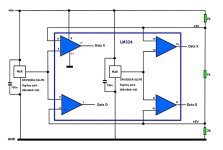Hugo Holden
Veteran Member
The recent post by Scottish Colin with the IR photos of the PET board and the work done by Nivag on logic signatures and the scope photos of the 20 or so scope recording I made of the DRAM support circuitry in the PET got me thinking. About all the possible ways we could build up a data base on the PET to assist repairs. I have also been playing around with a simple HP logic probe that uses LED's.
One interesting thing about this LED probe, the intensity of the LED gives a clue as to the likely duty cycle of pulses on the pins. In this case HP used very small sized red LED's. These sorts of clips are easy to make too with a logic test clip and adding LED's, I have posted the design of one before. It is not just if the LED is lit, or not, there is more information there in the case that they are lit up.
Imagine for example; a camera was set up and the clip was moved to all of the 16 and 14 pin TTL IC's on the PET board and a photo was taken and assembled into a large photo. The photo would show a gigantic pattern indicating the conditions of all the IC's each with their own unique LED light pattern. In a way, it would be somewhat similar to the IR photo and the image could be used as a type of reference in fault finding PETs.
Of course the LED logic probe is no substitute for a scope. But it still can provide useful pattern recognition information, provided there is a known normal reference pattern for each IC on the board.
One interesting thing about this LED probe, the intensity of the LED gives a clue as to the likely duty cycle of pulses on the pins. In this case HP used very small sized red LED's. These sorts of clips are easy to make too with a logic test clip and adding LED's, I have posted the design of one before. It is not just if the LED is lit, or not, there is more information there in the case that they are lit up.
Imagine for example; a camera was set up and the clip was moved to all of the 16 and 14 pin TTL IC's on the PET board and a photo was taken and assembled into a large photo. The photo would show a gigantic pattern indicating the conditions of all the IC's each with their own unique LED light pattern. In a way, it would be somewhat similar to the IR photo and the image could be used as a type of reference in fault finding PETs.
Of course the LED logic probe is no substitute for a scope. But it still can provide useful pattern recognition information, provided there is a known normal reference pattern for each IC on the board.




